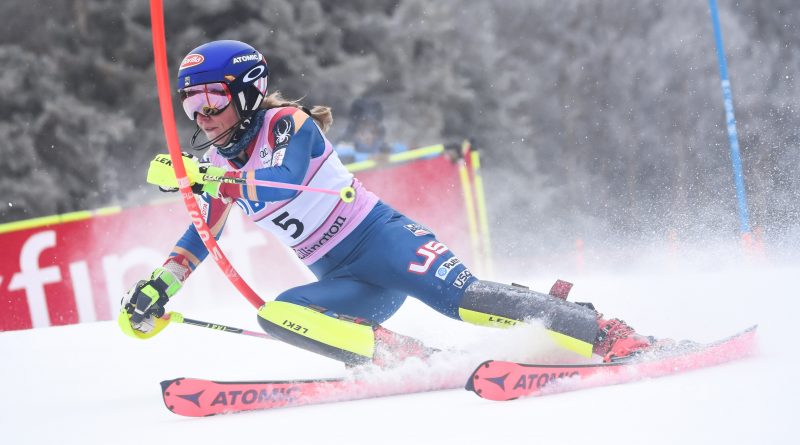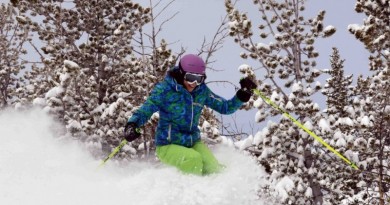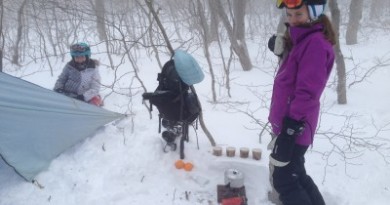7 Ways to Hold on Ice From an Olympic Racing Coach
When conditions get firm and ice strikes, use these pointers to be ready so you can cruise on through to a great day of skiing in any conditions.
When the ski report hiccups “loose granular”, a sugary texture crated by groomers after a thaw-freeze cycle, conditions are likely to get icy, especially on early season weekends and the holiday weeks when traffic can scrape a slope clean.
For most of us, that’s a time to head to the lodge. But for ski racers, a hard slick surface is something they look forward to. While the rest of us skid and scrape, they fly down, carving swooping turns like the surface was butter. How do they do it?
Mike Morin spent 10 years as head technical coach of U.S. Ski Team helping Olympians win on race courses purposely injected with water to make them as firm as possible. Now, as alpine director of Stratton Mountain School, one of the premier ski racing academies in Vermont, he teaches athletes of all levels how to carve turns on firm conditions. He offers these seven tips to help skiers get a better grip:
![When the ski report hiccups “loose granular”, a sugary texture crated by groomers after a thaw-freeze cycle, conditions are likely to get icy, especially on early season weekends and the holiday weeks when traffic can scrape a slope clean. For most of us, that’s a time to head to the lodge. But for ski racers, a hard slick surface is something they look forward to. While the rest of us skid and scrape, they fly down, carving swooping turns like the surface was butter. How do they do it? Mike Morin spent 10 years as head technical coach of U.S. Ski Team helping Olympians win on race courses purposely injected with water to make them as firm as possible. Now, as alpine director of Stratton Mountain School, one of the premier ski racing academies in Vermont, he teaches athletes of all levels how to carve turns on firm conditions. He offers these seven tips to help skiers get a better grip: Tune your skis. Most ski racers have their skis professionally tuned before every race. Most recreational skiers may wait a month to sharpen their edges. Morin urges skiers to visit a local ski shop to have their edges honed professionally. For reference, most elite skiers have at least a 3-degree side bevel on their skis, the angle that lets the edge of the ski cut into the surface like a knife. World Cup racers may have 7-degree side bevels. Ski with lots of edge angle. Now that you have that beveled edge, you need to make it work by making sure the edges angle into the snow. Think of using a knife to cut into a piece of cheese. You wouldn’t use the flat horizontal part, right? You’d use the vertical serrated edge. Same thing with skis: Edge angle refers to the amount you tilt your skis in a turn. The higher the edge angle, the better the edge grip. “You need to be willing to let your skis get out from under you with your weight concentrated on the outside ski,” says Morin, “If you keep your feet under your body, your skis will be too flat, and they’ll slide.” Create angles with your body. As your skis move side to side, your torso should remain upright. Rather than leaning into the hill, create an angle at the hip. “In powder, the inclination [leaning into the hill] can work,” explains Morin, “But on hard stuff, you need to separate your upper and lower body as a turn progresses. It not only forces weight onto the outside ski, but also allows the ski to roll much higher on edge. Engage the tips early in the turn. After your ski’s tip bites, the rest of your ski follows aggressively on edge around the arc. If you slam all of your weight into the middle of your skis at once, your skis will chatter. Let it flow. One common mistake is staying in a turn too long, especially if you start to skid. “Don’t hang on for life,” says Morin, “Move from one turn to the next.” And if you do skid a little, don’t worry about. You can get a better grip the next turn.” Aim for tiny traces of snow. The spray from others tends to accumulate along the sides of trails, just before a roll, and on the tops of moguls. The middle of trails, the downhill side of a knoll and places where skiers commonly brake, such as trail merges, tend to get scratched off quickly. Don’t get psyched out. “You need to be ready emotionally,” says Morin, “An icy patch can surprise you, and the slopes can get scraped off by the end of the day. Be ready for it, rather than reacting defensively.”](https://vtskiandride.com/wp-content/uploads/2016/02/Courtesy-Mike-Morin_Mike-Morin-head-shot-ski-jacket-240x300.jpg)
Tune Your Skis
Most ski racers have their skis professionally tuned before every race. Most recreational skiers may wait a month to sharpen their edges. Morin urges skiers to visit a local ski shop to have their edges honed professionally. For reference, most elite skiers have at least a 3-degree side bevel on their skis, the angle that lets the edge of the ski cut into the surface like a knife. World Cup racers may have 7-degree side bevels.
Ski with Lots of Edge Angle
Now that you have that beveled edge, you need to make it work by making sure the edges angle into the snow. Think of using a knife to cut into a piece of cheese. You wouldn’t use the flat horizontal part, right? You’d use the vertical serrated edge. Same thing with skis: Edge angle refers to the amount you tilt your skis in a turn. The higher the edge angle, the better the edge grip. “You need to be willing to let your skis get out from under you with your weight concentrated on the outside ski,” says Morin, “If you keep your feet under your body, your skis will be too flat, and they’ll slide.”
Create Angles With Your Body
As your skis move side to side, your torso should remain upright. Rather than leaning into the hill, create an angle at the hip. “In powder, the inclination [leaning into the hill] can work,” explains Morin, “But on hard stuff, you need to separate your upper and lower body as a turn progresses. It not only forces weight onto the outside ski, but also allows the ski to roll much higher on edge.
Engage the Tips Early in the Turn
After your ski’s tip bites, the rest of your ski follows aggressively on edge around the arc. If you slam all of your weight into the middle of your skis at once, your skis will chatter.
Let it Flow
One common mistake is staying in a turn too long, especially if you start to skid. “Don’t hang on for life,” says Morin, “Move from one turn to the next.” And if you do skid a little, don’t worry about. You can get a better grip the next turn.”
Aim for Tiny Traces of Snow
The spray from others tends to accumulate along the sides of trails, just before a roll, and on the tops of moguls. The middle of trails, the downhill side of a knoll and places where skiers commonly brake, such as trail merges, tend to get scratched off quickly.
Don’t Get Psyched Out
“You need to be ready emotionally,” says Morin, “An icy patch can surprise you, and the slopes can get scraped off by the end of the day. Be ready for it, rather than reacting defensively.”
Opener photo: Mikaela Shiffrin racing the Killington World Cup in 2018. Photo by Alex Klein



